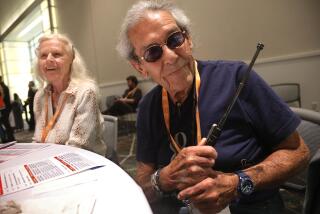Sharing the Roadway Can Be Hazardous : Ride Defensively, Don’t Panic and Keep Your Eyes on the Road
- Share via
Your foot pushes the pavement and propels your bicycle forward, filling you with the same spirit of adventure you felt the first time you took off the training wheels and navigated the sidewalk in front of your house.
Of course, now there are no cards in your bike’s spokes, no guiding hands to keep you from crashing to the asphalt. You used to circle the driveway; now you ride around a county. With the added distance comes more sophisticated and expensive equipment and something even more important:
The responsibility of sharing the road.
In discussing accidents, cyclists usually mention the automobile as the heavy. Ask a cyclist where his favorite ride is, and he’ll invariably answer that it is one away from traffic.
Cars may be a factor in cycling accidents, but many injuries occur when cyclists do not properly react to being in traffic.
So what do you do?
A couple days of riding and talking with several Orange County cycling club members produced these suggestions:
First and foremost, stay cool.
Say you’re peddaling down the road. The wind is whistling in your face, your legs and heart pumping, all’s right with the world and then you hear the steady drone of an engine behind you.
The sound gathers and builds as does your heart rate. As you head down the street, and the vehicle gains on you, the tension can grow so that you lose your capacity to reason. What is in fact a Chevette can seem like a tractor-trailer with Mr. Magoo behind the wheel.
According to “Bicycle Touring in the Western United States,” by Karen and Gary Hawkins, most bike accidents are not caused directly by cars, but are caused when cyclists becomes so concerned with the traffic behind them, that they forget how fast they are traveling and take a turn too fast, or lose concentration and drift off the road.
Meet Joan Hillman, drifter.
As she was riding one day, the sound of approaching cars shook her so that she drifted toward and finally struck a curb. Hillman sustained a compound fracture of her right arm.
“I was so concerned with what was behind me that I didn’t look where I was going, “ she said. “I learned there’s really no use in worrying. You ride as safely as you can, but worrying about what’s coming down the road won’t do you any good. In my case, it got me hurt.”
Many cyclists use a small mirror attached to their helmet to watch for traffic. This is good, but it should not deter from paying attention to what lies ahead.
Ray Blum of Downey received lacerations to his shoulder and face after a piece of a car’s tail pipe lodged in his front wheel.
“My front wheel stopped at 25 miles per hour,” Blum said. “But I didn’t.”
Both Blum and Hillman were riding in bike lanes when their accidents occured, which prompts the question: What is the purpose of a bike lane?
Bike lanes are set up by local governments in densely ridden areas. According to Pat Martin of the Department of Motor Vehicles in Costa Mesa, the bike lane entitles the cyclist to the same courtesy that any other motorist would receive on the road.
Cars are not allowed to drive in the lane unless they are preparing to make a right turn--then they are allowed to move cautiously into the lane 100 feet before their turn.
This is nicely said, but not always done.
“Cars don’t know how to deal with bicycles,” said Henry Pilcher of Anaheim Hills. “Especially bikes that are traveling 25 to 30 miles an hour. The cars will speed up to take a right turn and not realize you’re staying right with them. Then the car will stop suddenly and you can be in a whole lot of trouble.”
What’s the secret to avoiding this?
There is none--save a strong commitment to defensive riding.
It’s nice for people to say cyclists have as much right to the road as any car, but the fact is cyclists should ride as if everyone on the road cannot see them.
Assume the worst at all times--don’t panic, mind you--just always be thinking.
Always be ready to formulate an escape route if situations develop that may become threatening. And when all else fails, don’t forget the most useful of all maneuvers.
Stopping.


